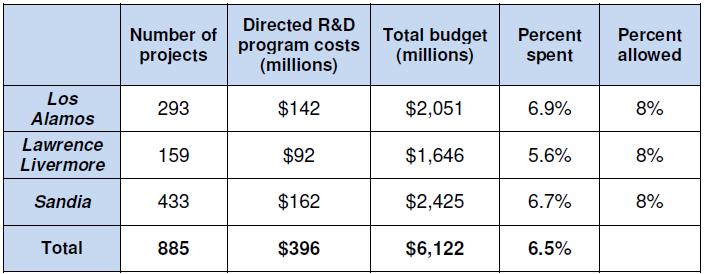The U.S. nuclear weapons laboratories have a program that allows their scientists and other researchers to conduct independent research and development (R&D) on subjects unrelated to the primary missions of the labs. This program—the Laboratory-Directed Research and Development (LDRD) Program—allows the labs to set aside up to 8% of their budgets each year for such R&D. Grants are awarded competitively, and funded by overhead charged by each laboratory to both its DOE and non-DOE sponsors.
The nuclear weapons production plants (the Kansas City Plant, Pantex, the Savannah River Site, and Y-12) and the Nevada Nuclear Security Site can also use up to 4% of their budgets for basic research, under the analogous Plant Directed Research and Development and Site Directed Research and Development Programs.
None of the sites use all the budgets allotted for these programs, so they have room to expand. (see Table).

Share of Total Budget Devoted to Directed R&D at Nuclear Weapons Labs, FY 2012 (Source: Department of Energy report)
The LDRD program is a good thing. According to a recent National Academy of Sciences study on The Quality of Science and Engineering at the NNSA National Security Laboratories, the program “is critical for the laboratories to maintain their needed S&E [science and engineering] edge.” For example, the study notes that roughly half of the patent disclosures and copyrights generated by the Sandia National Laboratories come from LDRD projects.
Some of the diverse research sponsored by this program at Los Alamos National Lab includes nanotoxicology (investigating the harmful effects of nanoparticles), carbon capture and storage (techniques to capture the CO2 produced by power plants and pump it deep underground to help combat climate change), quantum physics and its applications to faster computing, and new forms of cancer treatment using energetic ions rather than radiation.
For those who are worried about retaining scientific expertise, something that Congress has shown concern about in the past, LDRD (along with competitive salaries and benefits) helps make the labs an attractive place to work for scientists .
Enter the Energy and Water Development Subcommittee of the House Appropriations Committee. Its bill limits LDRD to 4.5% beginning in FY2014. The bill states that this should “free as much as $100,000,000 to be used for stockpile work.”
That estimate is correct: at 4.5%, the cost of the FY2012 LDRD program would have been $275 million instead of $396 million, for a savings of $120 million. But cutting this program is penny wise and pound foolish. Congress should leave it alone.
